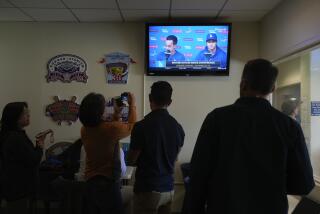Japanese Investors Turn Interest to Golf Courses : âGolf Frictionâ Stirs Fear Fees Will Become Prohibitive to Americans
WASHINGTON â As Japanese investors lose interest in buying American office buildings, they are queuing to buy âtrophyâ golf courses across this country.
In a handful of cases, the purchases are stirring a new controversy that is being called âgolf friction.â
Indisputably, the pace of golf-course sales has accelerated. In the last nine months alone, avid golfers from Japan have purchased such well-known American golf courses as Pebble Beach in California, Grand Cypress Resort in Florida and Princeville Makai-Prince in Hawaii.
Similarly, a group of Japanese investors is negotiating to buy a package of golf properties that includes PGA West, La Quinta and Mission Hills in California and Kiawah Island in South Carolina. More such purchases are on the way: Dai-Ichi Corp. of Myrtle Beach, S.C., is currently marketing about 75 U.S. golf courses to Japanese buyers.
According to a new report by Phoenix-based Mead Ventures, a research and publishing firm, Japanese buyers have bought at least 160 U.S. courses, up from only a handful five years ago. Japanese buyers now own virtually all the non-public golf courses in the state of Hawaii, the report said.
âJapan has a love affair with golf but a shortage of available land,â wrote Christopher Mead, founder and president of Mead Ventures. âAs a result, many Japanese go overseas to golf or to invest in golf courses. . . . It appears, moreover, that Japanese interest in American golf will deepen over the coming decade.â
Golf is a relatively new sport in Japan, but many residents have embraced it with a passion. About 15 million Japanese consider themselves golfers, although the expense is so high that most enthusiasts are forced to practice only at driving ranges, which operate 24 hours a day.
Membership at a golf course is generally prohibitive. When a spot is available, memberships at top courses cost at least $900,000 and range up to $2.7 million.
The solution? Golfing vacations, with air fare, hotel accommodations and green fees offered as part of a tour package. Consequently, Japanese investment in U.S. golf courses is soaring.
According to the real-estate accounting firm of Kenneth Leventhal & Co., outlays totaled about $202 million in 1988, doubled in 1989 and more than quadrupled in 1990 to an amount in excess of $1 billion.
And the 1991 total is likely to be much higher. The deal involving the PGA West, La Quinta and Mission Hills, announced in January, is itself worth an estimated $739 million.
In many cases, Japanese are the only bidders on golf courses for sale in the United States.
âThere is no money in America now,â said Donald Wizeman, president of DaiIchi. âBanks donât have it. Forget the S&Ls.; Thereâs no capital for large acquisitions. There isnât any investment money in the United States.â
At the same time, Japanese interest in other sorts of American real-estate purchases appears to be diminishing. Overall Japanese investment in U.S. real estate fell for the first time in a decade last year, dropping about 20% from 1989âs $14.77 billion.
Unlike office buildings and shopping centers, golf-course purchases have sometimes generated controversy. In a handful of incidents around the country, âgolf frictionâ has erupted.
âHarsh words on trade are exchanged between national or corporate leaders, while golf acrimony occurs between individuals, some of them standing face-to-face,â Mead wrote. âGolf friction, moreover, pits two proud elites against one another: wealthy Japanese versus wealthy Americans.â
In particular, the strength of the Japanese yen and the ability of Japanese tourists to pay more to play the U.S. courses, has sparked fears that the new owners could eventually raise fees to a level affordable to Japanese but not American patrons. Across the board, the buyers have paid prices far in excess of the levels previously paid for similar American courses.
Members of the Tamarack Country Club in Greenwich, Conn., for example, last year received Japanese offers of $50 million and $77 million for their course--double or triple what would have been paid by local purchasers, according to Mead.
Tamarack members were enthusiastic at first. Then they learned that under the contract, they would only be allowed to retain their membership for 10 years, after which the new Japanese owners would have the option of kicking them out. They turned down the offers.
Meanwhile, in affluent Marin County, Calif., longtime golfers at the San Geronimo Valley Golf Course were dismayed to learn that their golf clubâs new buyer, C&N; Corp., another Japanese firm, which bought the property in May, 1990, for $13 million, was considering privatizing the course and raising the membership fee to $50,000, with $400 monthly dues. Current memberships sell for $800, with $125 monthly dues, according to Mead.
âIt got a rather chilly reception,â said local resident William Sherman, who owns a golf-course realty company. âThe people who bought it didnât use good judgment.â
The new owners subsequently changed their thinking and retained the old prices.
Drastic increases of fees and dues are unlikely to occur, according to Dai-Ichiâs Wizeman. He said that although the Japanese are paying high prices, they realize that real estate is a long-term investment. Unlike American companies, he said, they are unlikely to jack up prices to obtain short-term profits at the expense of community goodwill.
And in fact, many Americans have been beneficiaries of the purchases. In many cases, Japanese owners have improved facilities, raised the pay of employees and shown themselves more attentive to the needs of the club members.
In addition, American golfers often receive a sort of subsidy from the buyers, who are charging higher rates to Japanese nationals than to Americans.
At the Honolulu International Country Club on Oahu, for example, resident memberships cost $19,000, while international memberships cost $150,000, according to the Mead report. Such two-tier rates will also be imposed at Minami Country Club, now under construction on Oahu, Mead said.
The thorniest problems, however, arise over environmental questions. In Hawaii, where the Japanese have purchased all available private courses, the only option remaining is to build new ones. With land at a premium on the tiny islands, Japanese builders or Japanese-backed groups have announced plans to build dozens of new courses.
Those proposals trouble environmental activists, who note that in such states as Hawaii and California, already troubled by serious water shortages, a well-maintained 18-hole golf course slurps down 1.5 million gallons of freshwater a day, curtailing what remains for human consumption.
In addition, golf courses are generally built next to waterways or the ocean, which means that pesticides and fertilizers used in maintaining the coursesâ appearance run off into the water, often harming local vegetation and marine life.
Environmental fears and a backlash against economic colonization by Japanese investors have led Honolulu Mayor Frank Fasi and Hawaii Gov. John Waihee to propose an impact fee to be levied on each new course. It is unclear whether the proposal is constitutional, or whether it will be enacted.
Environmental disputes have spread to the Pacific Northwest as well. In Washington state, two environmental groups have filed suit against a Japanese-backed venture that offered the stateâs cash-strapped Parks Commission $1 million to use land designated as a park to provide access to a golf resort.
Such controversies are expected to spread as Japanese purchases of golf courses and golf-course development sites grows. Mead projects that by the year 2000, Japanese owners are likely to have purchased between 500 and 1,000 U.S. courses.
Even 1,000 courses, however, would only total about 7% of the 15,000 golf courses in the United States.
âJapanese will certainly not take over the American golf business,â Mead wrote. âIndeed, they are unlikely ever to buy anything approaching a majority of U.S. courses. But they are going to make a mark on the industry in the coming decade, one that will make their impact in the 1980s seem faint indeed.â
More to Read
Inside the business of entertainment
The Wide Shot brings you news, analysis and insights on everything from streaming wars to production â and what it all means for the future.
You may occasionally receive promotional content from the Los Angeles Times.










